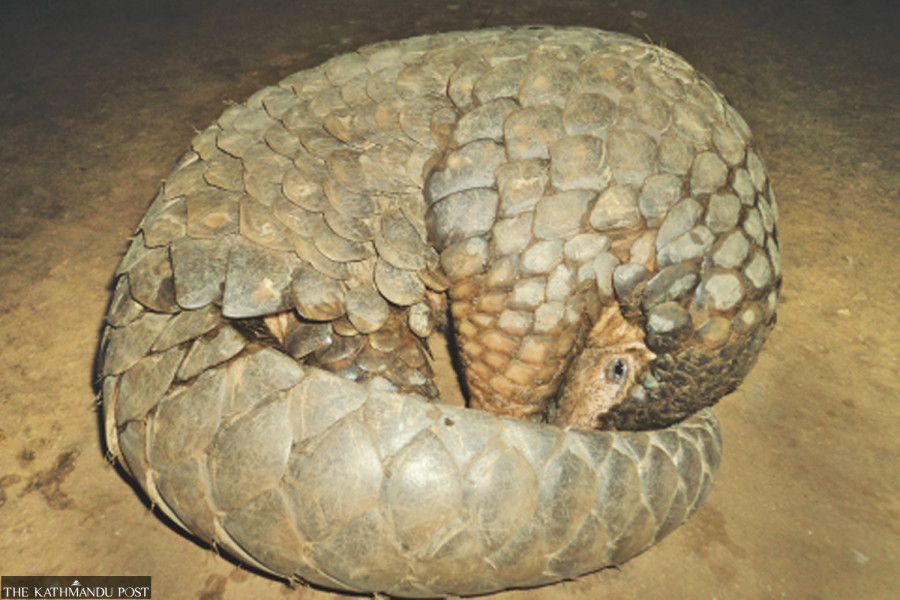National
Pangolins risk extinction in Khotang
Local officials are unsure whether the population dwindled due to poaching and smuggling or for not having a suitable habitat.
Dambar Singh Rai
Pangolins are on the brink of extinction in Khotang, a hill district in Koshi Province, due to unchecked poaching and smuggling of the endangered species.
According to the locals, pangolins, locally called Salak, were found in various places of Khotang until a few years ago. The pangolin population dwindled sharply as poachers killed the nocturnal animals for meat and scales, locals say.
“Numerous pangolins were seen in the Halesi area a few years ago. There used to be innumerable holes dug by the pangolins. But they are not sighted nowadays,” said Ramesh Kumar Raut, deputy mayor of Halesi Tuwachung Municipality. “Study should be conducted to find out whether the pangolin population dwindled due to poaching and smuggling or for not having a suitable environment.”
Two species of pangolin—Chinese Pangolin (Manis pentadactyla), known as Kalo Salak locally, and Indian Pangolin (Manis crassicaudata), locally called Tame Salak—are found in Nepal. The Chinese Pangolin is listed as critically endangered species while the Indian Pangolin is listed as endangered species in the International Union for the Conservation of Nature (IUCN)’s red list.
The Chinese pangolins are mainly found in Khotang. Jantedhunga Rural Municipality was the major habitat of the species in the past. But the pangolin population decreased sharply in the past few years.
“The poachers are active to kill pangolins for scales and meat,” said Birbal Kirati of Duplung in Jantedhunga-6. “Some itinerants visit settlement to settlement and provide up to Rs20,000 for a single pangolin scale. The pangolins are about to become extinct in the area now.” Kirati said that poachers and smugglers trade the pangolin scales through the Gaighat area of neighbouring Udayapur district.
The people’s representatives express their concerns over the dwindling pangolin population in the district. They urge the concerned authorities and security agencies to take immediate initiatives for the control of pangolin poaching and conserve the endangered species.
“Pangolins were seen quite frequently in various places of our local unit [Diprung Chuichumma Rural Municipality] until a few years ago,” said Lokendra Rai, chairman of the local unit. “Pangolins’ holes were found elsewhere in the forest areas. But they are not seen now as if they were already extinguished.”
Rai admits that the local units, conservation authorities and the security personnel should work together to conserve the endangered species.
The Division Forest Office in Khotang is unaware about the unchecked poaching of pangolins. Pashupati Dahal, chief at the division office, said that he is not aware about the pangolin population, their poaching and smuggling in the district. “The division office does not have a separate budget and programme for pangolin conservation,” Dahal said. “We, however, rescue the pangolins when required.”
According to the National Park and Wildlife Conservation Act 1973, anyone involved in poaching and trading of conserved species is liable to up to a 15-year jail term and a fine up to Rs1.5 million or both. Despite having strong legal provision, the wildlife poaching and smuggling is unchecked due to lack of awareness and effective implementation of the existing laws.
The pangolins are still spotted in Kepilasgadhi, Rawabesi and Khotehang rural municipalities and Diktel Rupakot Majhuwagadhi Municipality in Khotang.
“Most of the rural settlements are now deserted due to out-migration,” said Birendra Magar, ward chairman of Rawabesi-3. “The villages are without youths as they go for foreign employment. So the pangolins are saved in some villages.”
Pangolins live in burrows and they are active during the night to manage their food.
Termites and ants are major foods of pangolins in the wild. Pangolins are considered the friends of farmers as they biologically control the termites and ants that harm various crops.




 20.12°C Kathmandu
20.12°C Kathmandu















